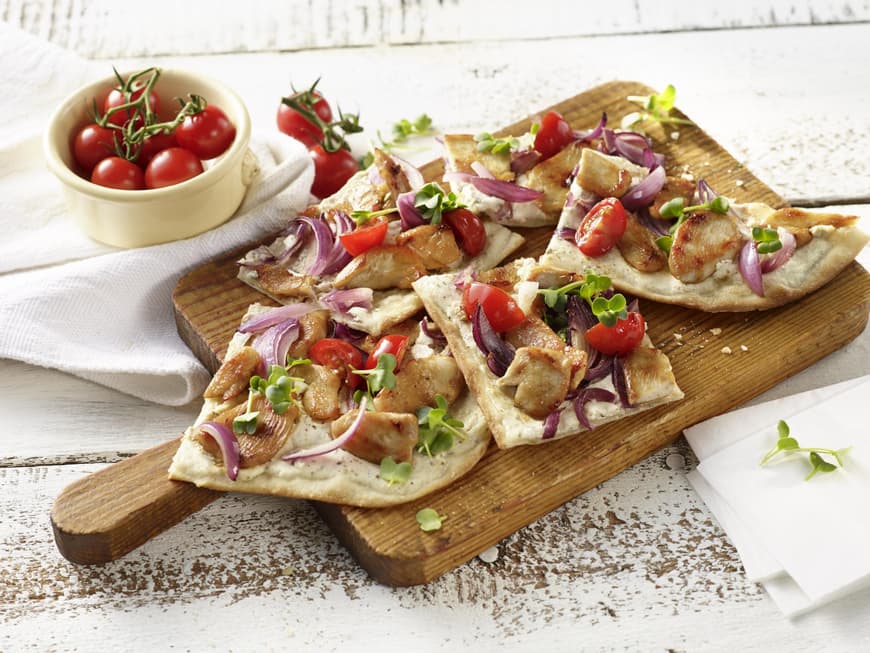The origin of the original tarte flambée
The tarte flambée with yeast dough actually originated in Alsace and is a real specialty there as well as in the neighbouring Palatinate and Baden. But tarte flambée is also popular in France, where it is called "tarte flambée". Traditionally, it was baked in a wood-fired oven over a very high heat before the bread was added and the flames were still blazing.
Of course, our tarte flambée dough recipe can be used to prepare more than just the traditional tarte flambée. In addition to the original from Alsace with bacon, onions and sour cream, there are now numerous tarte flambée variations with a wide variety of delicious toppings. From Serrano ham with Parmesan cheese and rocket, pear with goat's cheese, pumpkin and feta to a sweet version topped with fresh fruit - there are no limits to your imagination when it comes to topping and baking the tarte flambée. Traditionally, tarte flambée is made in the fall, when it is enjoyed with Federweißer wine - but of course you can enjoy these crispy cakes all year round.
What's in the tarte flambée dough?
If you want to make your own tarte flambée dough, you will find that there are various recipes with varying ingredients. While some mix the wafer-thin tarte flambée base with yeast to make a crispy tarte flambée, there are also versions without yeast or even with buttermilk. Another classic is the oil dough. Ultimately, it's all a matter of taste: yeast dough is always a little more time-consuming, but the result and taste speak for themselves. The other variants are correspondingly quicker, are also delicious, but are not as fluffy as only a yeast dough can be. However, not everyone tolerates yeast well, which is why oil dough is a popular alternative - also in terms of taste. Just try out your favorite variant! However, everyone agrees that the most important thing is that the dough should be rolled out as thinly as possible and come out of the oven nice and crispy.
Which cheese for tarte flambée?
Spicy and piquant cheeses such as Emmental, Appenzeller or Gruyere are best suited to the original recipe. Depending on the recipe, however, different types of cheese are possible: mozzarella goes great with a topping of tomatoes, blue cheese with grapes and walnuts, Parmesan with Serrano ham or fresh goat's cheese with figs. It all depends on the topping! To enjoy the full flavor of cheese, you should avoid ready-made products and grate the cheese fresh yourself.
Amazon top seller for cheese graters:
"Gourmet" multi-grater made of stainless steel from WMF for approx. 23 euros
Mini food processor: Moulinex DJ7535 Fresh Express 3-in-1 food processor for approx. 40 euros
Cordless hand cheese grater MR6 with rechargeable battery from Rommelsbacher for approx. 36 euros
Hand cheese grater with stainless steel fine drum from Zyliss for approx. 19.30 euros
Tarte flambée dough with oil - the simple basic recipe
Whether you want to top it in the classic way with spicy bacon and onion rings or prefer to use more unusual ingredients - with this basic recipe for tarte flambée dough, you have the perfect basis for any variation of the crispy pastry. The recipe is very simple and is made without yeast.
Ingredients:
- 200 g flour
- 2 tbsp oil, preferably olive oil
- 125 ml water
- 1 pinch of salt
Preparation of the tarte flambée dough:
- Place 200 g flour in a mixing bowl and make a slight hollow in the middle with your hand. Pour in 2 tablespoons of oil and 125 ml of water. Add a pinch of salt and knead well to form a dough.
Tip: Do not leave the dough to rest in the fridge, but work it immediately at room temperature. This will give it the right temperature. The longer you knead the dough, the smoother it becomes. This is because gluten is formed in this way, which provides a portion of suppleness! - Using a rolling pin, roll out the dough very thinly on a floured surface, place on a baking tray and top as desired.
- Depending on the topping, bake the tarte flambée for about 10 - 20 minutes at 200 - 250°C top/bottom heat.
Tarte flambée with yeast dough
Ingredients:
- 220 g flour
- 120 ml warm water
- 10 g yeast
- 1 pinch of sugar
- 1 pinch of salt
- 3 tbsp olive oil
Preparation:
- Place the ingredients in a large bowl and mix with the dough hook of a mixer.
- Once a homogeneous dough has formed, cover it with a clean kitchen towel and leave to rise for approx. 45 minutes. The volume should increase significantly during this time.
Various toppings and recipes for tarte flambée
Quick pizza dough: basic recipe with yeast
Tarte flambée with pear and camembert
Tarte flambée with chicken breast, caramelized cherry tomatoes and red onions
Party snack pizza roses
What to do to prevent the tarte flambée from tearing
Tarte flambée dough should be wafer-thin and crispy after baking - but how do you achieve this without the delicate, fragile dough tearing? It takes some practice, because no master has ever fallen from the sky. These are the best tips:
- Always work tarte flambée dough at room temperature, as it is then more elastic, supple and stretchy.
- Roll out the dough directly on the baking paper so that you can place both together on the baking tray later.
- Freshly prepared dough tends to stretch - simply leave the dough to rest for a while and cover it.
Then top as desired, such as in our recipe suggestions above!
Shelf life of tarte flambée
The fresh tarte flambée dough should of course be used as quickly as possible. However, it can also be kept in the fridge for one or two days.
If you want to make tarte flambée in advance, you can also freeze the dough, provided it is puff pastry or shortcrust pastry. Yeast doughs are not suitable for freezing!
Place the dough in the freezer immediately after preparation and use it within 6 months. To defrost, place the dough in the fridge overnight and then leave it at room temperature for 2 hours.
Ready-baked tarte flambée tastes best when it is still fresh and crispy. However, the tarte flambée does not spoil immediately! It can be kept in the fridge for up to two days. Tip: Bake it in the oven at a low temperature before eating to get it warm and crispy again.



